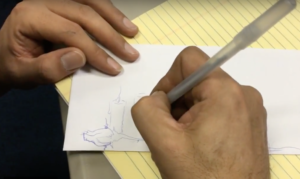[av_one_half first min_height=” vertical_alignment=” space=” custom_margin=” margin=’0px’ padding=’0px’ border=” border_color=” radius=’0px’ background_color=” src=” background_position=’top left’ background_repeat=’no-repeat’ animation=”]
[av_textblock size=” font_color=” color=”]
About digital storytelling
Digital storytelling is a method of creating and sharing knowledge using digital media to craft a personal narrative that speaks to broader social realities. Digital storytelling works against conventional, top-down approaches to knowledge production. It empowers participants to create their narratives in the context of a collaborative workshop setting.
Digital stories are effective at conveying lived experience. Through the workshop process, storytellers act as participant observers of their own lives, reflecting on their lived experiences by creating a story to explain and understand them.
The workshop process provides the opportunity for peer feedback and inspiration. A collaborative approach prioritizes storytellers and the knowledge they are sharing. They decide how to tell a story. They also acquire tools and hands-on skills for assembling the digital story.
The workshop opens with talking and writing prompts. Storytellers participate in a story circle, write scripts, edit scripts, do voice-over recordings. From there, they learn to integrate photo, video and audio elements. They storyboard, select images, engage in digital editing and assemble their stories. Participants receive feedback each step of the way from peers during group work and from trained workshop facilitators in one-on-one contexts. Stories evolve.
Ultimately, storytellers choose what to share and to consider which parts of their story might leave the circle and enter the public domain. Through the process, storytellers develop technology and media literacy skills. The approach infuses sensory aspects into experiences in a way that enchants knowledge.
Certain forms of knowledge carry authority. Digital stories have the potential to resonate with wider publics. As such, the project aims to build value and thus serves as an intervention against growing economic inequality. Finally, the crafting of digital stories within the structure of a group workshop offers opportunities to build solidarity among workshop participants and extend to wider communities.
Our methodology has been inspired by the Story Center whose facilitators have provided training to members of our team.
[/av_textblock]
[/av_one_half]
[av_one_half min_height=” vertical_alignment=” space=” custom_margin=” margin=’0px’ padding=’0px’ border=” border_color=” radius=’0px’ background_color=” src=” background_position=’top left’ background_repeat=’no-repeat’ animation=”]
[av_textblock size=” font_color=” color=”]

The Creative Economies project facilitated three workshops that fostered rich dialogue and produced thematic resonance across stories.

Further Reading:
Gubrium, Aline C., and Elizabeth L. Krause
2018 “Doing Your Life”: Narrative Intervention with Young Mothers as Storytellers. Human Organization 77(3): 214-227.
Gubrium, Aline C., Elizabeth L. Krause, and Kasey Jernigan
2014 Strategic Authenticity and Voice: New Ways of Seeing and Being Seen as Young Mothers Through Digital Storytelling. Sexuality Research and Social Policy 11(4): 337–347.
Gubrium, Aline, and Krista Harper
2013 Participatory Visual and Digital Methods. Walnut Creek, CA: Left Coast Press.
[/av_textblock]
[/av_one_half]